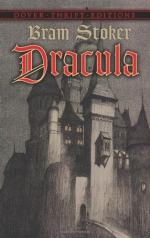|
This section contains 2,770 words (approx. 10 pages at 300 words per page) |

|
SOURCE: Kirtley, Bacil F. “Dracula, the Monastic Chronicles and Slavic Folklore.” Midwest Folklore 6, no. 3 (fall 1956): 133-39.
In the following essay, Kirtley traces the origins of Dracula to Russian monastic chronicles and Slavic folklore.
Bram Stoker's Dracula, that somewhat belated apparition from the sub-literary pits of Gothic horror fiction, has enjoyed a continuous notoriety since its first printing in 1897. Not only has the novel been republished numerous times, but its adaptions to the stage1 and to the cinema have repeatedly attracted crowded audiences. In the United States the story's impact has been sufficiently pervasive to furnish popular speech with a connotative tag in the figure of the vampire Dracula, whose mere name is evoked to suggest a stereotype of that shuddery, but not uncozy, fright purveyed by certain types of class-“C” motion pictures.
As might be expected, the materials out of which Bram Stoker put together his shocker...
|
This section contains 2,770 words (approx. 10 pages at 300 words per page) |

|


